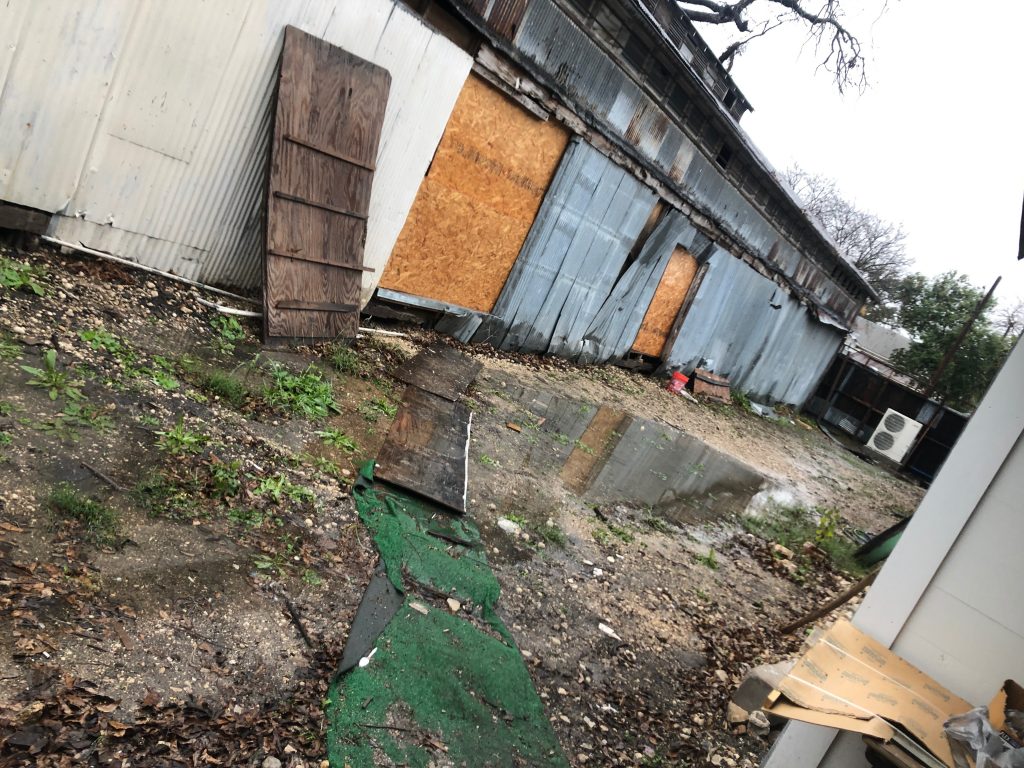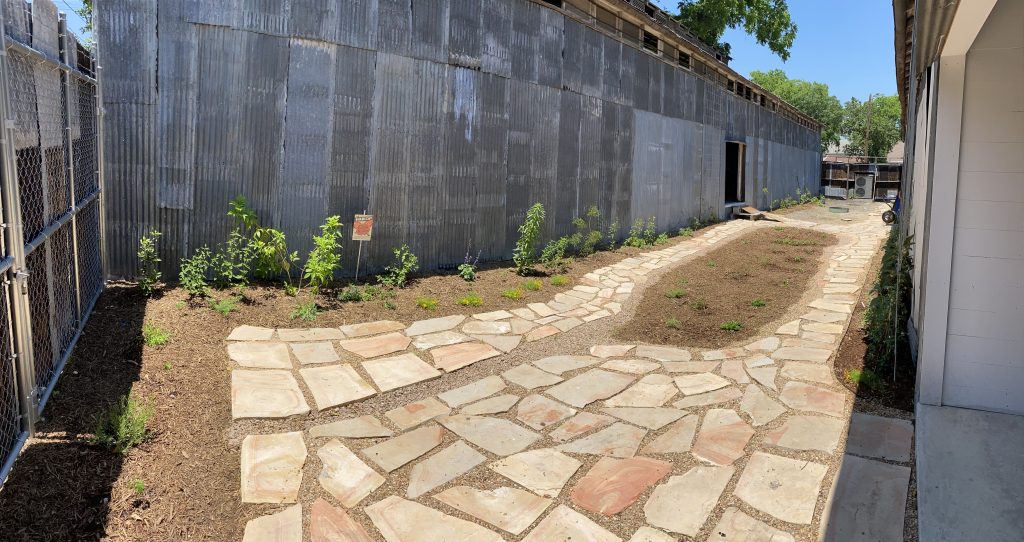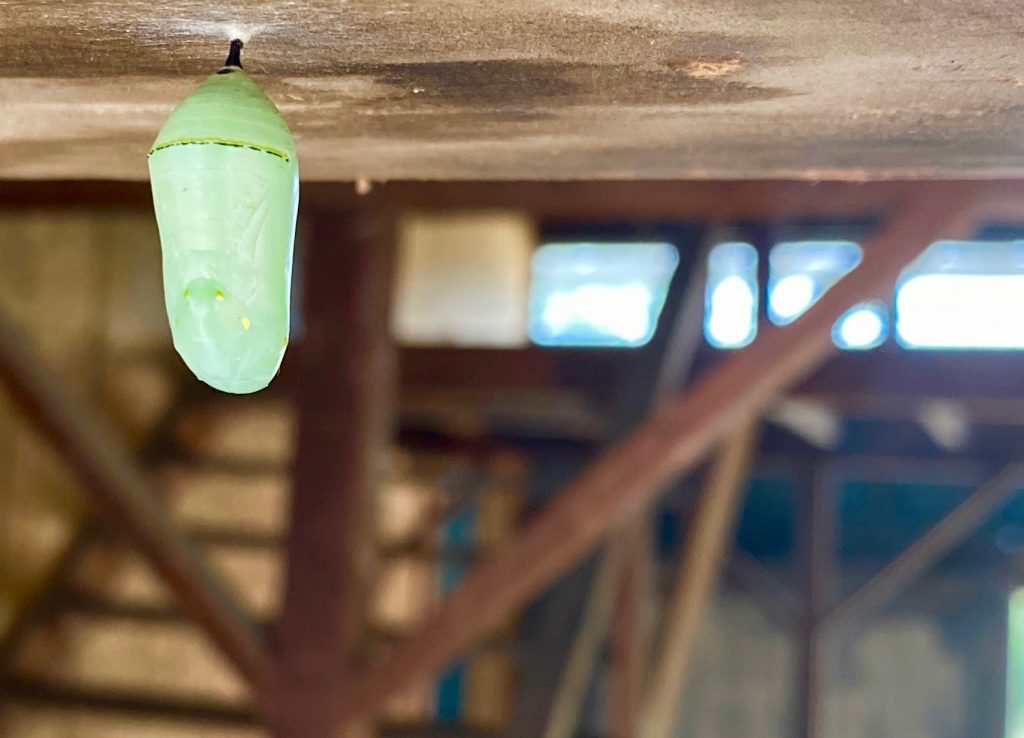
Gutters riddled with holes dumped gallons of rainwater with each shower. Photo by Monika Maeckle
Transformation takes time, and such is the case at the Wherehousebarn, a set of old barns located in San Antonio’s historic Dignowity Hill neighborhood.
The Eastside site, less than two miles from the Alamo, once housed a cabinet factory. Then it became a staging workshop for Fiesta floats–the iconic, decorated exhibits that roll down Broadway each spring to celebrate San Antonio’s history. Over the years, the seemingly out-of-place red barns devolved into blighted warehouses and a home to rats, squirrels, feral cats, a spectacular native pecan tree, and 10,000 square feet of impervious cover and compacted soil.
Our family purchased the property in early 2017 as the Peppergrass Group. After three years and various plans, projects and drama, the Wherehousebarn opens for business in July, offering affordable warehouse space and artist studios for tenants who appreciate community, funky environs and wildlife visitors at work.
One of many defining attributes of the Wherehousebarn is the newly installed pollinator rain garden that connects the two warehouses. With the help of Charles Bartlett and Albert Del Rio, local landscape experts at Green Haven Industries, Inc., the former driveway has been transformed into a pollinator habitat that already has brought diverse wildlife–as well as okra, cucumbers and watermelon–to the neighborhood.

Wherehousebarn pollinator rain garden, open for business. Photo by Monika Maeckle
Following a demolition, the space between the 1920s-era wooden barns became a drainage problem, thanks to ancient gutters filled with holes–and no budget in the renovation project to replace them. Thus, in addition to pollinator habitat and edible landscape, the gardening project’s goals included creating a rain garden to capture the run-off from 2,880-square feet of galvanized metal roof.
Each rain event of one inch produces 1,728 gallons of water that dumps into the area between the two barns. Given San Antonio’s average annual rainfall of 30 inches per year, that’s almost 52,000 gallons of water every 12 months.
Following showers, the passage between the barns became a massive mud puddle that caused the pier-and-beam foundations to shift seasonally.
Bartlett and Del Rio tackled the area, starting in February. The pair opted for grading the space with rakes rather than renting a Bobcat mini-tractor, as other landscaping companies had suggested. “It’s too hard to control,” said Bartlett, 81, who’s been gardening since he was a child.

“Soil” at the Wherehousebarn. Photo by Monika Maeckle
The “soil” was the biggest challenge. Heavy equipment and construction activity had compacted the earth with nails, glass, gravel, stone, asphalt and wood filling in the limestone base. Bartlett and del Rio removed the detritus with rakes and shovels, depositing the debris into a dumpster. Such compromised growing conditions require super durable plant selection for best chances of survival, Bartlett remarked.
The competing demands of drainage and a level sitting area further complicated the plan. “We needed a sloping site to assist with water drainage,” said Bartlett. Choosing plants tolerant of periodic ‘wet feet’ as well as the brutal Texas heat also posed a challenge.
Then, COVID-19’s impact on spring plant sales and nursery inventory made plant selection difficult. Typically, Bartlett and Del Rio would attend the native plant sales that take place in Central and South Texas each spring. But not this year. “All the native plant sales were cancelled due to the pandemic, so private individuals became the primary source for plant materials,” said Bartlett.
The resulting plant list, more than 45 species and 130+ specimens, includes native favorites like Gregg’s mistflower, Cowpen Daisy, Wedelia harvested from the San Antonio River, and Goldenrod and Frostweed transplanted from a Hill Country Ranch. It also includes nonnatives like Tropical milkweed and Star Jasmine. Later in the spring, okra, cucumber and watermelon plugs were introduced.
It didn’t take long for the butterflies to show up. Gulf fritillaries had already set up shop on wild passionflower vine that had managed to eke out a life in the unwelcoming soil. Several monarch butterfly caterpillars hatched from spring migrants heading north in March. Chrysalises resulted in the most unlikely places. Bees also found their way to the Wherehousebarn yard, as cucumber seedlings (pollinated by bumblebees and other bees) installed in late April bore their first fruit in mid June. First okra pods were harvested about a week later. Watermelon coming soon.
Bartlett said many of the plants chosen for the site will mature quickly and should be impressive by the end of the summer. The vines will require more time to develop, but should cover the trellises in about 18 months. With no sprinkler system, hand watering will be part of the office routine when summer heat sets in and rains stop flooding the swale. Johnson grass and other uninvited plants will be pulled or sprayed with 20% vinegar.
Like every garden, the Wherehousebarn is a process, not a project. We’ll be providing updates right here.

Pollinator habitat signs available in our shop.
Related Articles
- Adding pollinator habitat to resilience gardens can boost yields and relieve stress
- HOAs resist native plant landscaping despite conservation benefits
- We did it! San Antonio pollinator habitat hits 510 by 2020
- Cowpen daisy: Unofficial pollinator plant of the year 2019
- How to plan a successful butterfly garden
- Mostly native butterfly garden outperforms lawn every time
- Downtown River walk plot converts to pollinator garden, creature haven
- Converting your Lawn to a Butterfly Garden
- A year in the life of an urban butterfly garden
Like what you’re reading? Don’t miss a single article from the Texas Butterfly Ranch. Sign up for email delivery at the bottom of this page, like us on Facebook, follow us on Twitter, @monikam or on Instagram.


Wow! What a wonderful journey of possibility, persistence, vision , and intuitive wisdom and smarts to create the design, clean up the site, and build it anew. Bless your landscapers!
I remember the first time I saw a Great Spangled Fritillary here in Massachusetts. I was stunned by its size and those amazing silver spots. And then I fell in love with the name! Sounds if it should be a name for a brass fanfare !
Bless you and thank you for all you have done for this beautiful slice of Earth’s life.
Simply wonderful! Thank you so much for this uplifting report in these trying times!